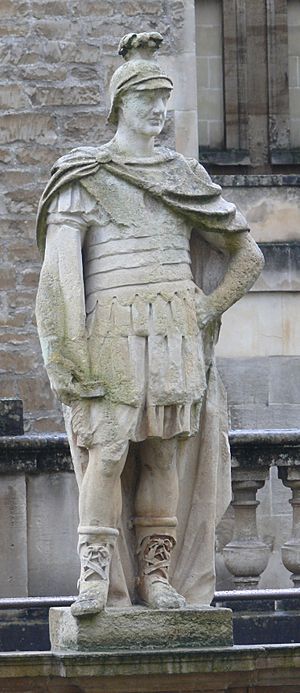Publius Ostorius Scapula facts for kids

Publius Ostorius Scapula was an important Roman general and leader. He was in charge of Roman Britain from 47 AD until he died in 52 AD. He is famous for defeating and capturing a British leader named Caratacus.
Contents
Who Was Publius Ostorius Scapula?
Publius Ostorius Scapula's father was also named Publius. He might have been related to Quintus Ostorius Scapula. Quintus was one of the first commanders of the Praetorian Guard, a special group of Roman soldiers.
Ostorius Scapula's Career in Rome
We don't know much about the early part of his career. He became a type of Roman official called a suffect consul, probably in 46 AD. This was an important job in the Roman government.
Governor of Roman Britain
In the winter of 47 AD, the Roman emperor Claudius chose Ostorius Scapula to be the second Roman governor of Britain. He took over from Aulus Plautius.
The Romans already controlled the south and east of Britain. They had also made friends with some tribes outside their controlled areas. However, other tribes still fought against Roman rule. These tribes thought a new governor would not want to start fighting so late in the year. So, they began to attack and rebel.
Ostorius Scapula quickly showed them they were wrong. He attacked fiercely and did not give the British tribes time to get ready. He even said he wanted to take away all weapons from Britons living south and east of the River Trent and River Severn. Some historians think this meant he wanted the Fosse Way road to be the new Roman border.
Dealing with Rebellions
The Iceni tribe, who lived in Norfolk, had chosen to be friends with the Romans. But they did not like Ostorius's plan to disarm everyone. They led other tribes in a rebellion. Ostorius defeated them by attacking a strong fort on a hill, possibly Stonea Camp. It was a tough battle. Ostorius's son, Marcus Ostorius Scapula, won a special award for bravery during the fight. The Iceni tribe stayed independent, and Prasutagus was likely made their friendly ruler.
After stopping this rebellion, Ostorius began to explore beyond the Roman border. He had a successful campaign against the Deceangli tribe in north Wales in 48 AD. This was a smart move because it separated the tribes in North Britain from those in Wales.
However, he had to return east because a group of the Brigantes tribe rebelled. This rebellion was quickly stopped. But it showed that the Roman system of having allied tribes could be risky. Roman army groups called legions were sent to the area to keep the peace.
Romanizing Britain
During his time as governor, Ostorius also helped make the safer southern parts of Britain more Roman. In 49 AD, he started Britain's first Roman town for retired soldiers at Camulodunum (modern Colchester). He also likely set up a Roman town with special rights at Verulamium (St Albans).
Ostorius was better at fighting than at politics. The lowlands controlled by Rome were not very rich. Most of Britain's valuable metals were in areas not controlled by Rome. Getting these resources would have to wait for later years.
The Fight Against Caratacus
Meanwhile, Caratacus, a leader whose tribe had been defeated earlier, became a leader again. He led the Silures tribe in southeast Wales. Ostorius controlled their uprising by building many Roman forts. This pushed Caratacus north into the lands of the Ordovices tribe.
After several years of small, surprise attacks, Ostorius finally forced Caratacus into a big battle in 51 AD. The battle probably happened near the River Severn. The Ordovices had built strong defenses on a steep hill above the river. It looked very hard to attack. But Ostorius's soldiers were eager to fight, and they easily defeated the Britons.
Caratacus's wife and daughter were captured, and his brother gave up. Caratacus himself ran away to the land of the Brigantes. However, their queen, Cartimandua, was loyal to Rome and handed him over in chains.
Continuing Resistance
After this victory, Ostorius was given special honors. But the win did not completely stop the fighting in Wales. The Silures tribe especially kept attacking Roman troops. This was partly because Ostorius had publicly said they were so dangerous that they should be wiped out or moved away.
A large Roman army group building forts in Silures land was surrounded and attacked. They were only saved with great difficulty and many losses. The Silures were very angry about Ostorius's threats. They started taking Roman prisoners and sharing them with other tribes. This helped unite the tribes and create a new resistance movement.
Death and Legacy
Ostorius died unexpectedly in 52 AD. The Roman writer Tacitus said he was "worn out with care." His death left Rome with a growing problem on its British borders. Some people believe he was buried in Clawdd Coch in Wales.
Silurian raids continued even after his death. They defeated a Roman army group before Aulus Didius Gallus arrived as the new governor. The area was finally made peaceful about 25 years later by Sextus Julius Frontinus.
Family Life
A woman named Sallustia Calvina is known to have been married to a Publius Ostorius Scapula. She might have been the wife of the governor or his father. If she was the governor's wife, she might have been the daughter of Gaius Sallustius Passienus Crispus.
Images for kids


